Fundamental Skills of Sports — Badminton Class 7 Notes Physical Education Unit 3 Free PDF
Introduction to Badminton
Badminton is a fast-paced sport that enhances physical fitness, hand-eye coordination, and reflexes.
- It is played with a shuttlecock and a racket, either in singles (one player on each side) or doubles (two players on each side).
- The aim is to hit the shuttlecock over the net into the opponent’s court.
- Mastering various skills such as serving, grip techniques, and footwork is essential for playing badminton effectively.
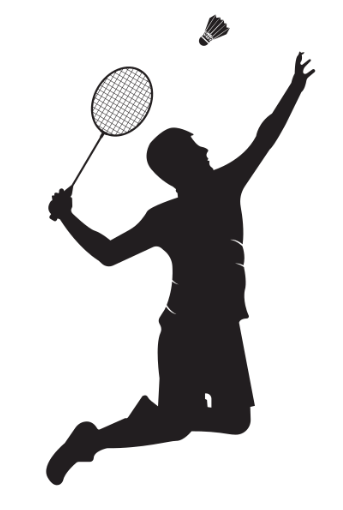
Forehand Grip and Air Toss
The grip is how you hold the racket, and the stance is the initial stationary position of your body for executing the desired skill. Both are key for playing better badminton.
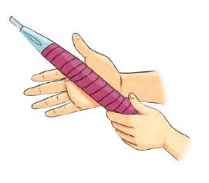
How to Play:
- Hold the racket with a handshake grip, ensuring your index finger is slightly higher on the grip.
- The racket should be perpendicular to the floor with your thumb resting gently on the lower left side.
- Practice tapping the shuttlecock into the air using the forehand grip.
- Try to keep the shuttlecock in the air as long as possible without dropping it.
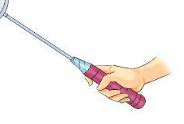
Key Points:
- Proper grip enhances control over the racket and shuttlecock.
- Forehand grip is essential for most shots during a game.
Backhand Grip and Air Toss
The grip refers to how you hold the racket, while the stance is your initial stationary position for executing the desired skill. Both are key skills for playing better badminton.

How to Play:
- Place your thumb on the back of the handle with the rest of your fingers comfortably wrapping around the handle.
- Ensure that your grip is not too tight, allowing for smoother movement.
- Practice tapping the shuttlecock five times using the backhand grip without dropping it.
Key Points:
- The backhand grip provides control for shots played from the opposite side of the body.
- Maintaining a relaxed grip will allow for better wrist flexibility.
Footwork Skills
Good footwork helps you reach the shuttlecock quickly across the court. It includes different steps and movements that make it easier to move around the court and stay balanced.
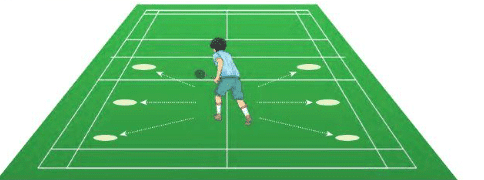
How to Play:
- Practice chassé steps, where one foot follows the other without catching up.
- Focus on moving sideways, diagonally forward, and backward with controlled, short steps.
- Set up a drill with six shuttlecocks and six buckets. Practice using proper footwork to place the shuttlecock in the buckets.
Key Points:
- Footwork allows players to move quickly and stay balanced on the court.
- Practicing different footwork movements ensures efficient court coverage.
Backhand Low Serve
For the backhand low service, the shuttlecock must pass from one service court to the diagonally opposite service court and the rest of the service rules should be followed. The backhand low service passes close to the top of the net and lands at the front of the diagonally opposite service area.
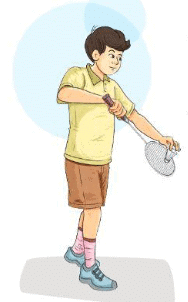
How to Play:
- Apply the backhand grip and hold the shuttlecock at waist level.
- Swing the racket forward with your wrist to ensure a smooth, low trajectory over the net.
- Aim to land the shuttlecock just past the short service line.
Key Points:
- The low serve is essential for keeping the opponent close to the net and gaining control.
- Precision and control are key for executing an effective backhand low serve.
Backhand Lift
It is easier to generate power in this stroke. This stroke will provide more recovery time to reach the centre of the court.

How to Play:
- Use the backhand grip and position your body sideways.
- Swing the racket upward using your wrist for control and hit the shuttlecock below the net tape.
- Follow through gently after the shot to maintain balance.
Key Points:
- The backhand lift allows for a controlled return, giving you more time to prepare for the next shot.
- Timing and technique are critical for executing an accurate backhand lift.
Forehand Lift
When the shuttlecock is low, you can use this shot to lift it high and far. This gives you more time to prepare for the next shot.
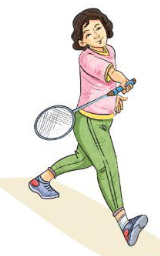
How to Play:
- Hold the racket with a forehand grip and position your body sideways.
- Swing the racket upward and hit the shuttlecock with a smooth, controlled motion.
- Focus on hitting the shuttlecock high and deep towards the opponent's backcourt.
Key Points:
- The forehand lift is useful for both defensive and offensive strategies.
- It provides more time to prepare for subsequent shots.
Forehand High Serve
This serve sends the shuttlecock high and far into the opponent's side of the court. It’s a good way to start the game and push the opponent back.
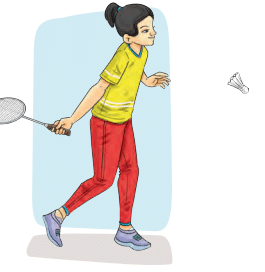
How to Play:
- Use a forehand grip and stand with your non-racket foot forward.
- Swing the racket upward smoothly, holding the shuttlecock by the feathers.
- Focus on sending the shuttlecock high and deep, aiming to push the opponent back.
Key Points:
- The high serve is effective for starting a rally and putting pressure on the opponent by pushing them to the back of the court.
- Proper trajectory and timing are crucial for a successful high serve.
Forehand Low Serve
There are two types of forehand serves — high serve and low serve. We will learn low serve in this lesson.
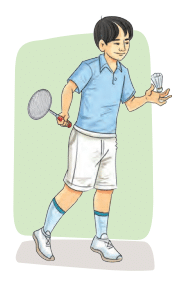
How to Play:
- Stand sideways in the service box with the racket and shuttlecock held high.
- Drop the shuttlecock slightly towards the front and lower the racket while bending your wrist.
- Aim for the shuttlecock to land just over the net in the opponent’s court.
Key Points:
- The low serve is essential for controlling the pace of the game and preventing the opponent from attacking.
- Accuracy and precision are key to executing this serve effectively.
Forehand Drive
The forehand drive is an offensive flat shot that is usually played over the net. Its purpose is to put pressure on the opponent by shortening their reaction time.
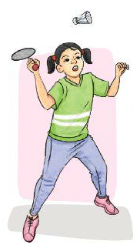
How to Play:
- Hold the racket with a forehand grip and position your body with slightly bent elbows.
- Swing the racket forward with a relaxed wrist, hitting the shuttlecock in front of your body.
- Aim for a flat, fast shot over the net to make it difficult for the opponent to return.
Key Points:
- The forehand drive is used for attacking and placing pressure on the opponent by reducing their reaction time.
- Consistent execution and good timing are essential for success.
Backhand Drive
The backhand drive is an offensiveflat shotthatis usually played over the net. Its purpose is to put pressure on the opponent by shortening their reaction time.
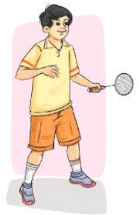
How to Play:
- Use the backhand grip and position your non-racket shoulder toward the shuttlecock.
- Swing the racket forward, making contact with the shuttlecock in front of your body.
- Follow through slightly and return to the ready position.
Key Points:
- The backhand drive is used to put pressure on the opponent with quick returns.
- Power and control are key to making this shot effective.
Takeaway: The backhand drive is an offensive shot that increases the speed of rallies and forces quick reactions from the opponent.
Forehand Clear
It is an essential badminton stroke for sending the shuttlecock to the rear end of the other team's court. Depending on the circumstances of the game, this shot can be played defensively or offensively.
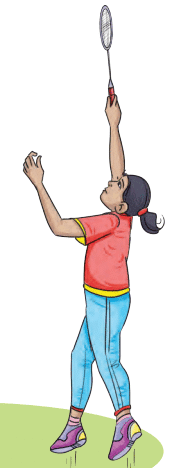
How to Play:
- Stand sideways with your non-racket shoulder facing the net.
- Shift your weight to your rear foot and swing the racket forward in a throwing action.
- Contact the shuttlecock high and in front, then follow through to complete the shot.
Key Points:
- The forehand clear is used for both defensive and offensive play.
- It is essential for clearing the shuttlecock to the back of the court and gaining control of the game.
Takeaway: The forehand clear is a vital stroke for defending and creating opportunities in the rally.
Forehand Drop
The forehand drop shot is a gentle hit that lands close to the net on the other side. It’s a tricky way to bring your opponent closer to the net and take advantage.
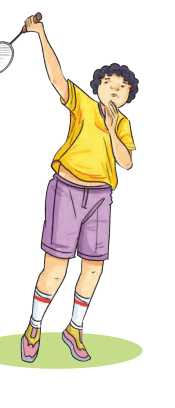
How to Play:
- Use a forehand grip and position your body sideways.
- Shift your weight to your rear foot and swing the racket gently to drop the shuttlecock close to the net.
Key Points:
- The forehand drop is a deceptive shot that challenges the opponent’s positioning and forces them to move.
- It is useful for setting up other shots in the rally.
Badminton Match
To apply the skills learned during the lesson in a real match setting.
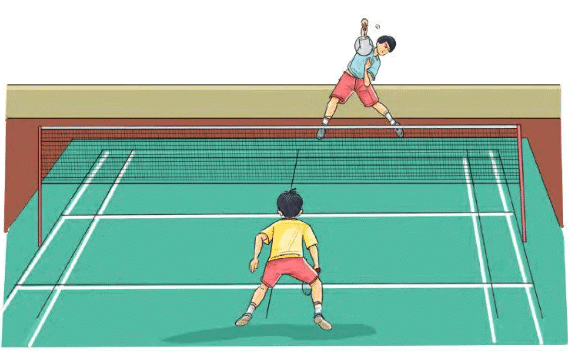 Badminton Match
Badminton Match
How to Play:
- Players compete to score five points first.
- After serving and winning a rally, the player scores a point.
- Players take turns serving and keep playing until one player wins.
Key Points:
- Focus on using the techniques learned (serves, drives, lifts) to win rallies.
- Practice focus, strategy, and maintaining a consistent performance throughout the game.
Conclusion
This chapter introduces the fundamental skills required for playing badminton effectively. Through different exercises and games, students improve their grip, footwork, and shots. The chapter also emphasizes strategy, timing, and reaction speed, making it essential for overall fitness and badminton performance.
|
23 docs|3 tests
|
FAQs on Fundamental Skills of Sports — Badminton Class 7 Notes Physical Education Unit 3 Free PDF
| 1. What is the importance of the forehand grip and air toss in badminton? |  |
| 2. How do I perform a backhand low serve correctly? |  |
| 3. What footwork skills are essential for playing badminton? |  |
| 4. What are the differences between a forehand high serve and a forehand low serve? |  |
| 5. How can I improve my backhand lift technique in badminton? |  |





















